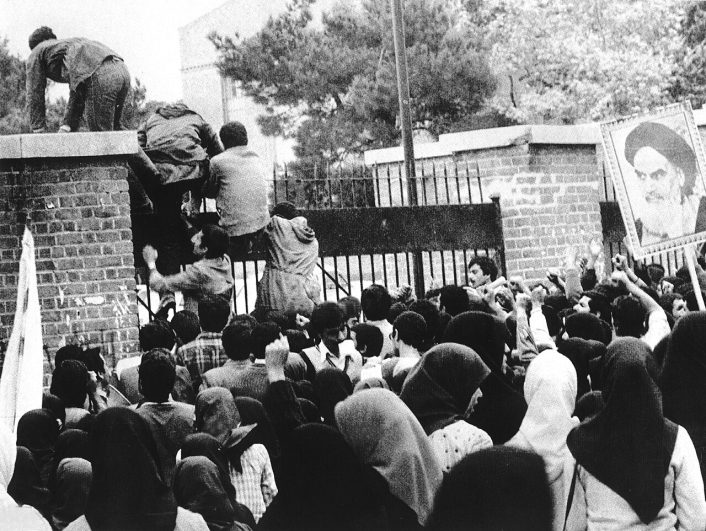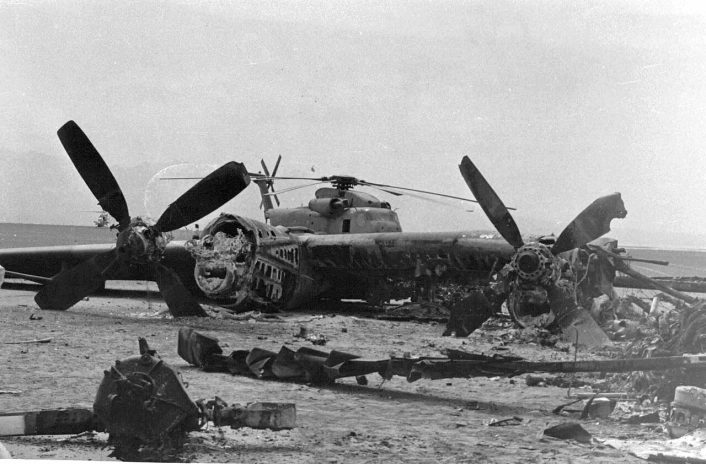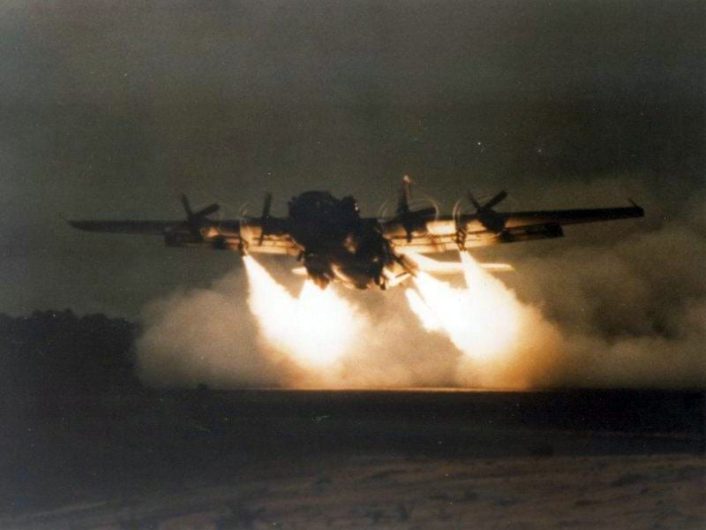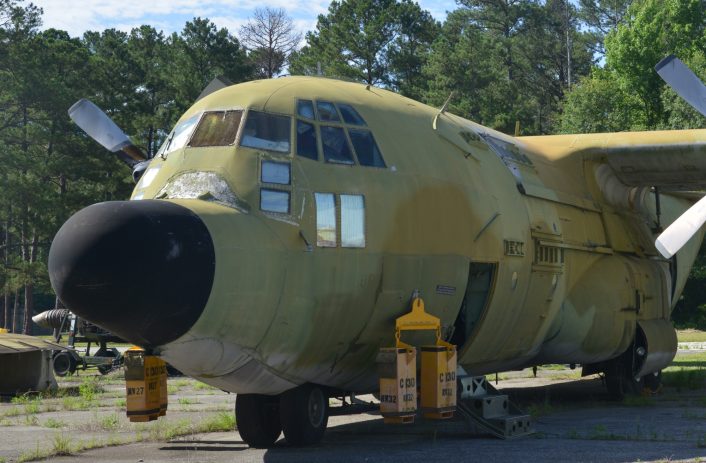Inside the audacious plan to convert a C-130 Hercules into a rocket-assisted Super STOL aircraft capable of landing in a confined urban space for a daring hostage rescue in Iran.
Faced with an ever increasingly embarrassing situation and reeling from a disappointing rescue attempt, President Jimmy Carter ordered a second rescue attempt of the American hostages held in Iran in 1980. This one, even more bold than the first, involved putting a fixed-wing aircraft down in a sports stadium and departing the stadium with hostages and rescuers onboard. A special super STOL aircraft would be needed for such a mission.
The Iranian Hostage Crisis
On Nov. 4, 1979, during the Iranian Revolution, Muslim Student Followers of the Imam’s Line stormed the United States Embassy in Tehran, Iran, taking 66 hostages including diplomats and other personnel. The majority of the hostages (52), would not see freedom for 444 days. Americans were glued to their television sets every evening, listening to the news only to hear Walter Cronkite of CBS end his broadcast daily with a report on how many days the hostages had remained in captivity. The United States, a superpower, seemed helpless against the extremists.

Under pressure to act and amid a diplomatic breakdown, President Jimmy Carter authorized Operation Eagle Claw, a rescue attempt in the darkness of April 24-25, 1980, that was doomed to failure after some of the helicopters involved suffered malfunctions, causing the mission to be scrubbed. It ended with a fatal collision involving a United States Navy (USN) RH-53D Sea Stallion helicopter striking a United States Air Force (USAF) EC-130 Hercules aircraft on the ground during refueling for the retreat, killing eight United States servicemen.
Five RH-53D helicopters loaded with ammunition and supplies had to be left behind as American frustration grew. Carter immediately ordered a second rescue attempt.

Operation Credible Sport
Planning for a second rescue attempt was authorized under Project Honey Badger. Plans were devised and exercises rehearsed, some with success. However, the issues with equipment failures of helicopters during Eagle Claw resulted in plans utilizing fixed-wing STOL (Short Takeoff and Landing) capable aircraft being conceived. Aerial refueling and usage of fixed-wing aircraft would allow greater range, reliability, and also avoid ground refueling that had led to the fatal fireball of the first rescue attempt.
Under Honey Badger, the newly created Joint Test Directorate (JTD) was placed in charge of exploring solutions to the hostage crisis. The hostage extraction operation would be a joint effort involving the USAF, USN, and the United States Army Delta Force, along with Lockheed-Georgia. The team was asked to provide a large ‘Super STOL’ aircraft with fixed wings to reliably extract the hostages and rescue team. This would replace the troublesome helicopters of the first rescue attempt.

Operation Credible Sport was conceived as part of Honey Badger, involving landing a highly modified Lockheed C-130 Hercules air transport on a soccer field in Amjadien Stadium, across the street from the U.S. Embassy, and utilize it to extract the freed hostages and the Delta Force rescue team. The C-130 would then depart and land on a USN aircraft carrier in the Gulf, providing treatment to the expected wounded.
Amjadien Stadium had 33 ft walls and seating stands around it and offered less than 500 ft of area for landing and taking off. The C-130 would have to get airborne very quickly, almost straight vertical, to extract the load of hostages, crew, and rescuers. This, along with the task of landing on an aircraft carrier, would require extensive research, modifications, and testing – although a C-130 had landed on an aircraft carrier previously in November 1963 during a demonstration involving the USS Forrestal (CVA-59).

The XFC-130H
The current variant of the C-130 at the time was the H model, which required close to 3,500 ft in order to become airborne with its maximum gross weight of 155,000 lbs, and loaded at half maximum it still needed about 1,400 ft to land and takeoff. It seemed an impossible task to get such a large aircraft to operate in such tight quarters, but Lockheed and the planners went to work.
At first, the idea was to add JATO (Jet-Assisted Take-Off) bottles to the C-130 to increase the thrust during take-off, but engineers soon calculated a total of 58 large bottles would be needed, greatly increasing the weight of the aircraft to unacceptable levels.
It was decided rockets offered the best solution, a lot of rockets to be exact. Eight forward pointed rocket motors from the Navy’s ASROC (Anti-Submarine Rocket) weapons were mounted around the forward fuselage of the aircraft to provide immediate braking. Eight more rocket engines from RIM-66 Standard surface-to-air missiles under the fuselage pointed backwards to lift the C-130 into the air, and an additional pair of ASROC rockets were placed vertically under the tail to force the rear of the aircraft up to prevent tail strikes during the steep angle that would be experienced lifting off.

Eight rockets from Shrike anti-radiation missiles were also mounted vertically above the wheel wells to cushion the aircraft’s descent as it dropped almost vertically to land. Four more Shrike rocket motors were mounted under the wings to help control the C-130’s yaw during the rapid takeoff.
Additional modifications included updated electronics along with terrain following radar, a new navigation system, and countermeasures. Ailerons were extended and double-slotted flaps installed. The structure of the aircraft had to be strengthened as well to compensate for the addition of the rocket forces, and a tailhook added for the carrier landing.

A total of three aircraft would be modified and designated the XFC-130H. The conversions occurred shrouded in secrecy at Eglin Air Force Base (AFB) in Florida, with the aircraft being drawn from the 463rd Tactical Airlift Wing at Dyess AFB, Texas. The aircraft were numbers 74-2065, 74-1683, and 74-1686. 74-1683 would be ready to fly first in October 1980.
Multiple test flights were conducted over nine days, with the aircraft performing very well, using only 100 ft for its ground roll during takeoff and ascending to 300 ft after moving forward a combined distance of 200 ft. The aircraft broke several records.
However, during a test of the full rocket-assisted profile on Oct. 29, some of the forward-facing rocket motors fired too soon during landing, causing the aircraft to stall and to drop to the ground, and the rockets above the wheel wells failed to fire to soften the blow. The starboard wing broke off and the aircraft burst into flames. There were no casualties. The aircraft was stripped of critical components and quickly buried on site at the testing grounds of Wagner Field, Florida, to insure the secrecy of the project.
A second XFC-130H (74-1686) was ready for delivery but negotiations through Algeria and the election of Ronald Reagan and his assuming office on January 20, 1981 prompted the immediate release of the hostages by Iran, ending the crisis.

Aircraft 74-1686 with the new designation of YMC-130H was used as a testbed in the Operation Credible Sport II program, leading to the new special operations MC-130H Combat Talon II. Once placed on display at the Museum of Aviation at Robins AFB, Georgia, 74-1686 now resides at the Empire State Aerosciences Museum, Schenectady, New York. Aircraft 74-2065 was returned to Dyess AFB with the 317th Airlift Group.









